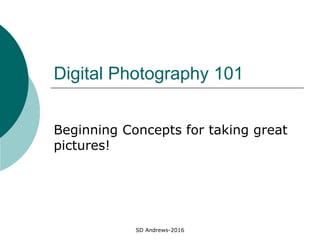Digital Photography 101 2016.ppt
•Download as PPT, PDF•
0 likes•12 views
Basic Photography
Report
Share
Report
Share

Recommended
Recommended
More Related Content
Similar to Digital Photography 101 2016.ppt
Similar to Digital Photography 101 2016.ppt (20)
Using smartphone photography to build your brand on any budget

Using smartphone photography to build your brand on any budget
11 Outdoor Photography Tips for Shooting with Your Smartphone

11 Outdoor Photography Tips for Shooting with Your Smartphone
Fcoa rideau home_digital_photos_slide_share_april_2019

Fcoa rideau home_digital_photos_slide_share_april_2019
Recently uploaded
Recently uploaded (20)
Call Girls Aligarh Just Call 8617370543 Top Class Call Girl Service Available

Call Girls Aligarh Just Call 8617370543 Top Class Call Girl Service Available
How to order fake Worcester State University diploma?

How to order fake Worcester State University diploma?
codes and conventions of film magazine and website.pptx

codes and conventions of film magazine and website.pptx
Engineering Major for College_ Environmental Health Engineering by Slidesgo.pptx

Engineering Major for College_ Environmental Health Engineering by Slidesgo.pptx
Headshots and Personal Branding by Julie King Photography

Headshots and Personal Branding by Julie King Photography
SB_ Pretzel and the puppies_ Rough_ RiverPhan (2024)

SB_ Pretzel and the puppies_ Rough_ RiverPhan (2024)
Call Girl In Chandigarh ☎ 08868886958✅ Just Genuine Call Call Girls Chandigar...

Call Girl In Chandigarh ☎ 08868886958✅ Just Genuine Call Call Girls Chandigar...
ppt seni budaya kelas xi, menganalisis konsep,unsur,prinsip dan teknik

ppt seni budaya kelas xi, menganalisis konsep,unsur,prinsip dan teknik
SB_ Dragons Riders of Berk_ Rough_ RiverPhan (2024)

SB_ Dragons Riders of Berk_ Rough_ RiverPhan (2024)
FULL ENJOY —📞9711106444 ✦/ Vℐℙ Call Girls in Ghaziabad | Delhi🫶

FULL ENJOY —📞9711106444 ✦/ Vℐℙ Call Girls in Ghaziabad | Delhi🫶
Call Girls Sultanpur Just Call 📞 8617370543 Top Class Call Girl Service Avail...

Call Girls Sultanpur Just Call 📞 8617370543 Top Class Call Girl Service Avail...
Top Rated Lucknow Escorts Service, ₹5000 Best Hot Call Girls With Room +91-82...

Top Rated Lucknow Escorts Service, ₹5000 Best Hot Call Girls With Room +91-82...
Digital Photography 101 2016.ppt
- 1. SD Andrews-2016 Digital Photography 101 Beginning Concepts for taking great pictures!
- 2. SD Andrews-2016 Understanding your digital Camera - Models Subcompact Compact Super Zoom Advanced SLR
- 3. Front of Camera SD Andrews-2016
- 4. Back of Camera SD Andrews-2016
- 5. SD Andrews-2016 Features Most cameras have sufficient megapixels for everyday picture taking. For editing and professional printing you need 8 to 10 megapixels Optical Zoom vs. Digital Zoom – always go with at least 3X optical External memory card USB connectivity Good flash Easy to under buttons/features Batteries that can be recharged Lens can be protected Sturdy
- 6. SD Andrews-2016 Things to know Shutter Button- Half down is focus and light adapter – always pre-focus How to turn you flash on, auto, off, or red-eye… Take lens cover off If you use red-eye option, tell your subject – flash is delayed Turn your macro function on and off – for extreme close-ups Where the focus points are for your camera
- 7. SD Andrews-2016 Taking pictures – Some tips
- 8. SD Andrews-2016 Fill the Frame
- 9. SD Andrews-2016 Rule of Thirds
- 10. SD Andrews-2016 Rule of Thirds
- 11. SD Andrews-2016 Rule of Thirds
- 12. SD Andrews-2016 Macro Shots – Getting Close
- 14. SD Andrews-2016 Getting down on their level……
- 15. SD Andrews-2016 Getting down on their level…..
- 18. SD Andrews-2016 People and Portraits When photographing people take shots that are either: •Whole body including feet and head •Waist up •Head shot
- 19. SD Andrews-2016 Action Shots Focus on subject and hold onto that person Press shutter as you move and keep moving until picture is taken
- 21. SD Andrews-2016 Resolution Use highest resolution for pictures that will be printed or cropped Use 640X840 for web pages and power point
- 23. SD Andrews-2016 Your camera and the computer Upload your pictures to a computer and erase your storage device: Always name your folder (including data and activity) You can use a variety of programs and online services to display and print your photos including powerpoint or an editor like pixlr
- 24. SD Andrews-2016 Formats .JPG or .JPEG– easiest format to save .TIF – higher quality but uses more space .JPG and .GIF are used on web sites .RAW is highest quality but difficulty to work with
- 25. SD Andrews-2016 Some tips and suggestions Avoid mergers – telephone poles and strange objects sticking out of heads Never shoot into a light source Use your flash when shooting pictures in bright daylight Low light is best for outdoor shots – early morning, late in the day, cloudy
- 26. Adding Interest and Identification SD Andrews-2016
- 27. SD Andrews-2016 Plan your photos Take pictures of signs or plaques to help place your photos Consider the background – a simple background works best Take pictures in a series Think of your pictures as a group or set – how could they be used?
- 28. SD Andrews-2016 Plan your photos Take lots of pictures – they won’t all be great Take 2 shots of every person or scene every time Overlapping 1/3 or ½ of a previous shot allows you to create a series of shots that can be stitched together
- 29. Schoolwires and Web Photos If you intend to add captions keep your subject in the top 2/3 of the picture. Use landscape pictures unless you intend to edit. SD Andrews-2016
- 30. SD Andrews-2016